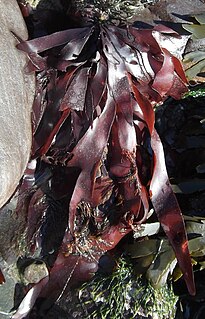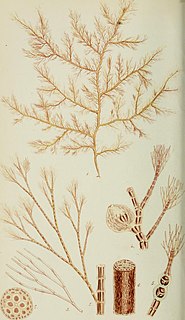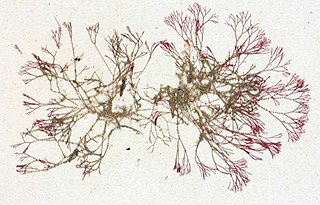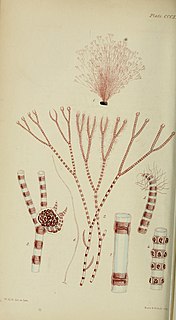
Palmaria palmata, also called dulse, dillisk or dilsk, red dulse, sea lettuce flakes, or creathnach, is a red alga (Rhodophyta) previously referred to as Rhodymenia palmata. It grows on the northern coasts of the Atlantic and Pacific Oceans. It is a well-known snack food. In Iceland, where it is known as söl[ˈsœːl̥], it has been an important source of dietary fiber throughout the centuries.

Atractophora hypnoides is a rare red alga (Rhodophyta) found in the British Isles, France and some Atlantic Islands and is the only species of the genus found in the British Isles. It is attached to the rock or other algae by a small basal disc and is much branched with downgrowing filaments which enclose the main branch or axis forming a cortex. Short filaments of limited growth radiate in whorls from the axis and frequently convert into hairs. The spreading filaments grow irregularly in a diffuse manner. Microscope examination is required for identification.
Schmitzia hiscockiana is a small, rare, red seaweed or marine alga of the phylum Rhodophyta or red algae. It was discovered and named in 1985.

Polysiphonia lanosa is a common species of the red algae (Rhodophyta) often to be found growing on Ascophyllum nodosum.
Polysiphonia atlantica is a small filamentous species of red marine algae Rhodophyta. The thalli form small tufts up to 3 cm long. The axes are ecorticate consisting of axial cells surrounded by four periaxial cells.
Polysiphonia denudata is a small red alga, Rhodophyta, growing as tufts up to 20 cm long without a main branch axis.

Polysiphonia fibrillosa (Dillwyn) Sprengel is a species of marine red alga in the Rhodophyta.
Polysiphonia furcellata (C.Agardh) Harvey is small marine red alga in the Division Rhodophyta.

Melanothamnus harveyi, Harvey's siphon weed, is a small marine red alga in the division of Rhodophyta.

Choreocolax polysiphoniae is a minute marine parasitic alga in the division Rhodophyta.
Polysiphonia opaca (C.Agardh) Moris et De Notaris is a small marine alga in the division Rhodophyta.

Polysiphonia simulans is a small marine alga in the division Rhodophyta.

Ceramium echionotum is a small marine alga in the division Rhodophyta.
Ceramium flaccidum is a small red marine alga in the Division Rhodophyta.

Ceramium cimbricum is a small red alga in the division Rhodophyta.
Ceramium gatitanum is a small marine red alga.

Ceramium strictum is a small marine red alga.

Ceramium virgatum, or the red hornweed, is a small red marine alga.

Gymnogongrus griffithsiae is a small uncommon seaweed.
Chylocladia verticillata is a medium-sized red marine alga.












